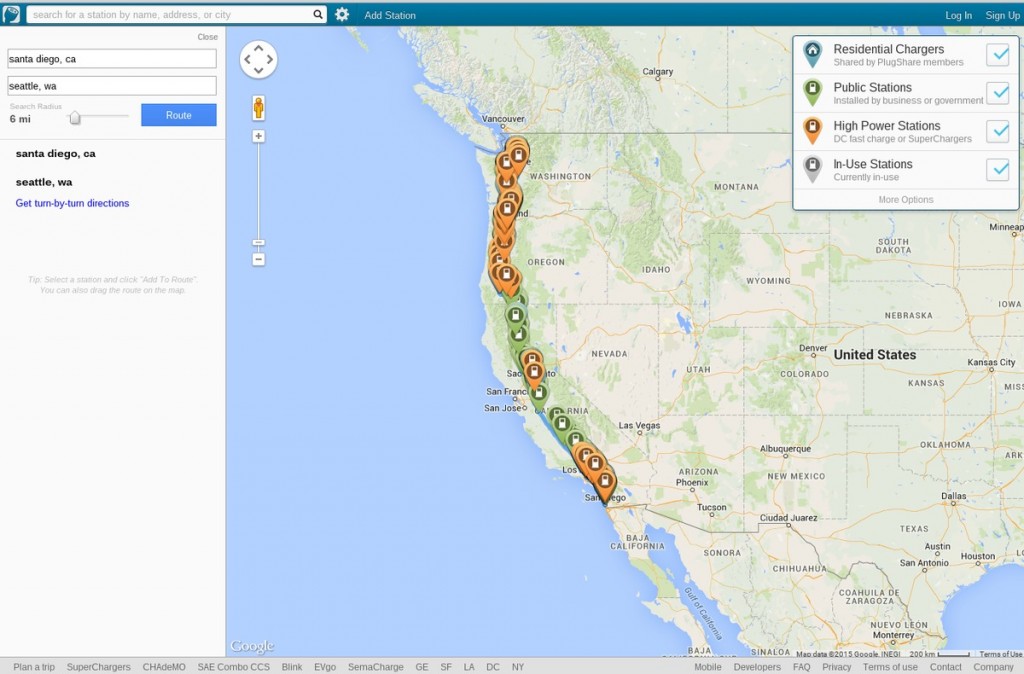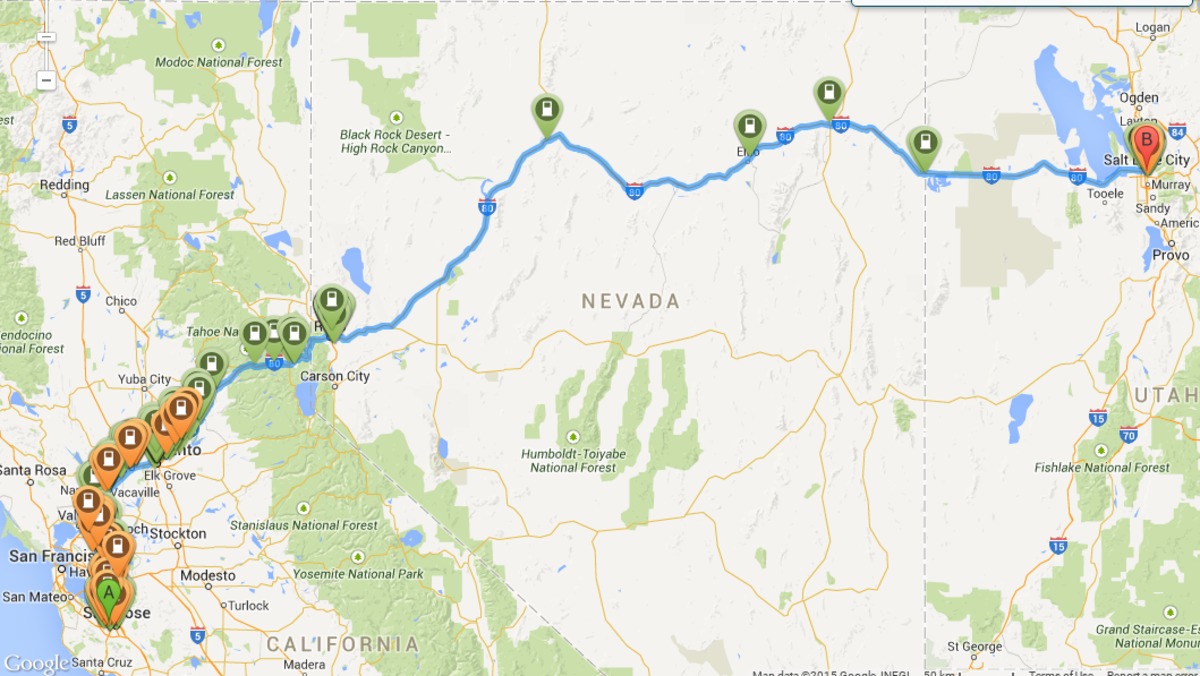PlugShare just became extremely more useful. It was already the best smart phone app for locating electric car charging stations, not just in the U.S. because its data extends to Australia, Europe and other places. What’s new is Recargo has added a Trip Planner that’s pretty useful. What’s shown is trip planning for a prospective BC-BC run that might happen later this year and we see that while there’s plenty of CHAdeMO stations, there’s some significant gaps.
This feature is possible to do by hand – if you’re patient. Simply get out a note pad and a pen/pencil (yes, old skool technology) and scribble down addresses of charging stations along the way. Then you go to Google Maps or some equivalent service, and check distances between each by hand. You can then list legs of your trip based on charging station location. Surely there’s a smart phone app to make the manual trip planning process easier, but such an app wouldn’t have charging station location information. PlugShare does have the right data, and now they’re offering trip planning.
And, yes, Tesla Motors revealed a trip planner feature for the Model S a few weeks ago. For those of us who can’t afford a Model S, PlugShare just gave us a pretty competent trip planner.
In use it’s simple and easy. On the smart phone app, in the default map view there’s a new button – there had been an arrow (to navigate to your current location), and a gear icon (for settings, like the filter for charging station types). The new button kinda looks like a crinkled map if you squint your eyes right, and sure enough it takes you to a new screen asking for starting and ending locations. On the desktop version there’s simply a text label reading “Trip Planner” which takes you to the same kind of screen. Simply enter two locations, tap the Search button, and you’re given a new map with the route and charging stations along the route.
That’s it – it’s so easy.
With the desktop version it’s possible to drag the route to select a different route. For example the above route takes you down I-5 but what if you want to do something different? For example I know there are CHAdeMO stations along California Hwy 99 and not I-5 in California – click on the route, drag it over to Hwy 99, and presto the route recalculates and the charging station list updates automatically.
The same click-and-drag-a-route behavior exists in Google Maps (PlugShare’s map technology is borrowed from Google).
The implementation as it stands is imperfect, so let me point out a couple flaws I see off the top of my head:
- The smart phone app doesn’t give estimated driving time information
- The desktop version does give estimated driving time, by popping you over to Google Maps. That’s cool, but the estimate doesn’t integrate charging time delays
- It doesn’t offer to save the route data somewhere for later reference
- It doesn’t help a multi-stage trip
- Neither version accounts for the kind of car you have, its driving range, charging time characteristics nor terrain
That last point is pretty complex, so let’s take it apart. The essential point is whether the trip planner can help you judge your ability to cross a specific gap in the route with the available charging stations.
Say your car gives an honest 85 miles electric range on flat ground. But your range after a fast charge session would be closer to 70-75 miles, because it’s tricky getting the car to 100% at a fast charger. Then if your route is mountainous, the effective range is probably reduced significantly. That means your 85 mile range electric car might be able to go only 50 miles into the mountains, even if you hit a fast charger at the base of the mountains. PlugShare’s trip planner doesn’t help you figure this out.
To be fair, I’m pointing at a difficult problem. Accounting for terrain first requires having terrain data, which probably isn’t available. I’ve been told it’s possible to interpolate terrain information out of some of the Google Map data, but you still have to develop an algorithm to estimate energy consumption effects on driving range based on terrain. And, since the PlugShare app doesn’t know your car’s state of charge any estimate it would give would be incomplete.
For example consider this route. The gap from the Sacramento Area to Reno is probably doable with most electric cars, but how do you get to Salt Lake City? The distance from Reno to Winnemucca is 165 miles, and from Winnemucca to Elko it’s 125 miles. Both those locations are RV parks, not regular charging stations, meaning you’ll be begging an RV park manager to let you charge your car. Even if the RV park manager was willing to do so, that 85 mile range electric car mentioned above wouldn’t make it because the distance is too far.
But I hear y’all saying “wait, why would someone with an 85 mile range EV take that trip?” And, yes, the Model S is the only EV that today is a good road trip car. But, why should those of us who can only afford the 85 mile range car be limited to trips in our neighborhood? Today I own such a car (a Kia Soul EV), but my previous electric car had only a 50 mile range, and I did take it on longer trips. For example, Mountain View to Monterey/Carmel and back in one day is over 200 miles of driving. With a 50 mile range EV that means a lot of charging time, but I made it and had a great time in Carmel, and I did similar trips plenty of times. The Kia Soul EV with almost twice the range and CHAdeMO is far better suited for longer trips, and I hope to do so this year. You can be sure I’ll turn first to the PlugShare Trip Planner.
Bottom line is that the PlugShare Trip Planner is a big step forward, but there is still a ways to go for it to be perfect.
Those of us who can’t afford a Tesla – we need a Trip Planner for the Rest of Us. PlugShare – you’re so close, please keep going, you’re headed in the right direction.
- The USA should delete Musk from power, Instead of deleting whole agencies as he demands - February 14, 2025
- Elon Musk, fiduciary duties, his six companies PLUS his political activities - February 10, 2025
- Is there enough Grid Capacity for Hydrogen Fuel Cell or Battery Electric cars? - April 23, 2023
- Is Tesla finagling to grab federal NEVI dollars for Supercharger network? - November 15, 2022
- Tesla announces the North American Charging Standard charging connector - November 11, 2022
- Lightning Motorcycles adopts Silicon battery, 5 minute charge time gives 135 miles range - November 9, 2022
- Tesla Autopilot under US Dept of Transportation scrutiny - June 13, 2022
- Spectacular CNG bus fire misrepresented as EV bus fire - April 21, 2022
- Moldova, Ukraine, Georgia, Russia, and the European Energy Crisis - December 21, 2021
- Li-Bridge leading the USA across lithium battery chasm - October 29, 2021
















